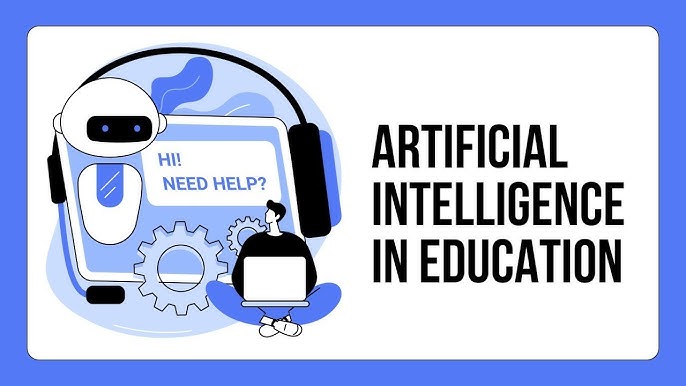
Artificial Intelligence (AI) is reshaping the landscape of education, offering personalized learning experiences and innovative teaching methods. This post delves into the various applications of AI in education, from adaptive learning platforms to intelligent tutoring systems. Explore how AI is revolutionizing the way students learn and educators teach, paving the way for a more inclusive and dynamic educational environment..
The integration of AI technology in education is reshaping the way students learn and educators teach. As the world embraces digital transformation, traditional classroom models are evolving, incorporating innovative AI-powered learning tools that provide tailored educational experiences. This shift is not merely a trend but represents a profound change in the educational landscape. From automated grading systems to virtual reality simulations, AI is paving the way for a smarter and more efficient learning environment.
The Role of AI Technology in Education
What is AI Technology in Education?
AI technology in education encompasses the use of artificial intelligence to enhance various educational processes. This integration can range from administrative tasks, such as enrollment and scheduling, to direct learning experiences that engage students in meaningful ways. AI educational platforms leverage algorithms and data analytics to optimize teaching methods, automate grading, and deliver adaptive learning paths tailored to each student’s needs.
The potential of AI in education is vast, with applications extending to language learning, skill development, and even higher education. For instance, AI-powered feedback in education allows for real-time assessments and constructive criticism, making it easier for students to understand their strengths and areas for improvement. This real-time feedback mechanism promotes a culture of continuous learning and growth.
The Benefits of AI Technology in Education

1. Personalized Learning with AI
One of the most significant advantages of AI in education is its ability to provide personalized learning experiences. In traditional classroom settings, a one-size-fits-all approach is common, which may not effectively cater to the diverse needs of individual students. AI-driven adaptive learning platforms can analyze each student’s progress, learning style, and preferences, customizing content to ensure that every learner can engage meaningfully with the material.
For instance, AI tools can track learning patterns, suggesting additional reading materials or interactive exercises that align with a student’s unique learning style. This data-driven approach not only fosters a deeper understanding of the subject matter but also helps students retain knowledge more effectively. With AI, the educational experience can become more student-centered, addressing individual needs and promoting self-directed learning.
2. Gamification in Education
Incorporating gamification in education through AI-powered tools can make learning more engaging and enjoyable. Digital platforms that utilize dynamic leaderboards, interactive quizzes, and reward systems motivate students to participate actively and strive for higher performance. By introducing game-like elements into the educational process, students are encouraged to approach learning with enthusiasm and excitement.
AI plays a pivotal role in gamified learning by introducing visually engaging and immersive experiences. For example, learning about historical events can be transformed into interactive simulations, where students navigate through key moments in history as if they were participants. Such immersive experiences significantly enhance student engagement and performance, as they not only retain knowledge but also develop critical thinking and problem-solving skills in the process.
3. Cost-Effectiveness of AI Tools
Another advantage of AI educational tools lies in their cost-saving potential. Automated grading systems relieve educators from the burden of administrative tasks, allowing them to focus more on personalized instruction and student engagement. By automating repetitive tasks such as grading assignments and tracking student performance, educators can dedicate more time to fostering meaningful connections with their students.
Moreover, AI for educational administration streamlines processes such as scheduling, data management, and resource allocation. Institutions can save on developing new learning materials as platforms like Second Nature provide tools to create interactive sessions with minimal effort. These cost savings can be redirected toward other educational initiatives, such as improving infrastructure, expanding digital resources, or enhancing extracurricular programs that further enrich student experiences.
4. AI-Powered Feedback and Assessment
Feedback is a crucial element of the learning process, and AI facilitates immediate and objective evaluations through automated assessments. This innovative approach allows students to receive timely insights into their performance, enabling them to identify mistakes and areas for improvement quickly. Such active learning with AI encourages students to take ownership of their education, leading to a more profound commitment to their learning journey.

AI-powered simulations offer practical applications in various educational settings. For example, role-playing exercises in sales training or language practice with AI avatars provide students with opportunities to hone their skills in a safe and judgment-free environment. By incorporating real-world scenarios into the learning process, students can develop essential competencies while building their confidence and preparedness for future challenges.
How to Implement AI Technology in Education
1. Adaptive Learning Platforms
To successfully implement AI technology, educational institutions can leverage adaptive learning platforms that create personalized learning paths for students. These platforms analyze data from assessments and interactions to tailor educational content that aligns with each student’s unique learning style and pace. By offering a customized learning experience, institutions can ensure that every student is fully engaged and able to progress without feeling overwhelmed or under-challenged.
2. Conversational AI in Education
Conversational AI in education has emerged as a powerful tool for language learning, skill training, and interactive learning experiences. AI-powered chatbots and virtual assistants can simulate real-life conversations, allowing students to practice speaking skills and receive instant feedback. This technology can be particularly beneficial in language learning contexts, where conversational practice is vital for fluency.
For instance, business students can engage with conversational AI to rehearse sales pitches and receive constructive feedback on their delivery. Language learners can practice dialogues with AI personas that respond in real-time, creating an interactive and immersive environment that enhances language acquisition. This hands-on approach not only boosts student engagement but also fosters a supportive atmosphere for learners to experiment and improve their skills.
3. AI for Business Learning and Development
AI technology extends beyond traditional educational settings and can be effectively integrated into corporate training programs. Companies can adopt AI-powered learning tools to facilitate training initiatives, such as onboarding, sales training, and leadership development. By utilizing AI-driven platforms, organizations can provide employees with interactive, scenario-based training experiences that enhance their skills and confidence.
For example, AI can assist in role-playing exercises where employees practice customer interactions, handle objections, and refine their communication skills. This approach not only makes training more engaging but also ensures that employees are better equipped to tackle real-world challenges. Furthermore, AI tools offer a scalable solution for organizations, allowing them to deliver high-quality training without the need for additional staff or resources.
Real-World Applications and Success Stories
1. Xavier University of Louisiana
The Xavier University of Louisiana is an excellent example of how AI technology can enhance educational experiences. The university has integrated AI tools to improve its sales courses, utilizing Second Nature to help students practice sales pitches. The platform provides AI-powered simulations that allow students to refine their skills while receiving instant feedback. This initiative has led to higher levels of student engagement, with many participants reporting increased confidence and improved performance in real-world sales scenarios.
2. University of Houston
The University of Houston’s Bauer School of Business has also embraced AI technology by automating the evaluation of role-playing exercises for over 1,300 students each semester using Second Nature. This AI-powered feedback in education not only reduces the workload on faculty members but also ensures that students receive timely, objective assessments that support their learning and growth.
3. Israel Ministry of Education
The Israel Ministry of Education has adopted Second Nature to assist elementary students with language learning. By leveraging the platform’s capabilities, students can engage in conversational practice with AI avatars, enhancing their English language skills in a supportive and interactive environment. This initiative highlights the transformative potential of AI in making language learning more accessible and effective for young learners.
Challenges of Integrating AI in Education

While the benefits of integrating AI in education are compelling, several challenges must be addressed to ensure successful implementation.
1. Privacy and Security Concerns
The collection and use of student data for AI analytics raise significant privacy and security concerns. Educational institutions must ensure that data collected by AI learning analytics is protected against breaches and misuse. Developing clear policies regarding data privacy, consent, and security protocols is essential to safeguard sensitive information and maintain student trust.
2. Ethical Issues and Bias
Another challenge involves the potential for bias in AI algorithms, which can affect the fairness and accuracy of assessments and recommendations. Educators and developers must prioritize ethical considerations by identifying and mitigating biases in AI systems. Regular audits and testing of algorithms can help ensure equitable treatment for all students and foster a more inclusive educational environment.
3. Infrastructure and Training
Successfully integrating AI requires a robust digital infrastructure and trained personnel. Schools and universities may need to invest in upgrading their technology and providing professional development for educators to effectively use AI tools. Ongoing training and support are crucial for educators to feel comfortable and confident in implementing AI solutions in their classrooms.
AI Has Much to Offer Educational Experiences
The integration of AI technology into education is not just a futuristic concept; it is a present reality that is already reshaping the educational landscape. As demonstrated by various success stories, educational institutions worldwide are leveraging AI to create more engaging and effective learning experiences. AI-powered learning tools
facilitate personalized education, streamline administrative tasks, and enhance student engagement through innovative gamification strategies.
However, the journey toward fully embracing AI in education is not without challenges. Institutions must navigate issues of data privacy, ethical considerations, and infrastructure requirements to ensure the responsible implementation of AI technologies. By addressing these challenges head-on, educational stakeholders can create a more inclusive, efficient, and empowering learning environment for students.
In conclusion, the future of education lies in the strategic integration of AI technology. As we continue to explore its potential, the opportunities for enhanced learning experiences are boundless. By embracing AI in education, we are not only transforming the way knowledge is imparted but also preparing students for a rapidly evolving world where digital literacy and innovation are paramount.

FAQs
- What are the challenges associated with implementing AI technology in universities?
Although AI can bring many benefits to university education, there are also a number of challenges in implementing it. Security and privacy are always concerns around AI tools, as are ethical issues regarding bias in algorithms and decision-making. Universities may need to invest in updating infrastructure to support AI technology, training faculty and staff to effectively utilize AI tools, and adapting traditional educational models to accommodate AI-driven teaching methods.
- How can AI enhance learning experiences within a university setting?
In a university setting, AI can personalize education to meet individual student needs, providing adaptive learning platforms that adjust content and pace based on student progress. With AI, universities can offer virtual tutors or chatbots for immediate assistance, and even enable immersive experiences to teach complex subjects through simulations and virtual reality.
Additionally, AI can automate administrative tasks to free up faculty time for more interactive teaching, enabling staff to give more attention to each student. Finally, AI-powered data-driven insights into student performance can inform university decision-making, improve resource allocation, and help generate more enjoyable and effective learning experiences.
- How do students perceive the use of AI in their university education?
When introduced effectively, with sufficient guidance and training, students are extremely positive about the use of AI in their university experiences. Today’s students are digital natives who view AI as cutting edge and a cool way to learn. They are comfortable interacting with digital personas and learning through screens, and they value the timely feedback, objective assessments, and constant availability that AI delivers.
- How difficult is it to use AI in education?
It depends on which solution you use, but when you choose the right platform it’s easy to apply AI in education. For example, Second Nature’s conversational AI solution has a user-friendly editor that makes it simple to create new simulations and educational learning experiences.
All you need to do is upload a PDF text, audio recording, or URL with information about the topic, choose a template from the extensive template library, and request a simulation. It just takes a couple of minutes to get a ready-to-use session for students to practice conversations for sales, business, or management situations, or rehearse interactions in the language they are learning.








